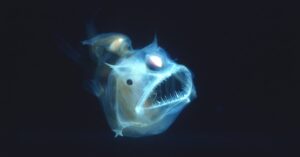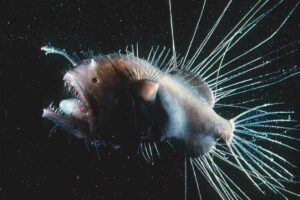Glow in the Deep: How Bioluminescent Creatures Help the Ocean

-Shivaan Darda

Imagine diving into the ocean’s pitch-black depths and suddenly seeing flickers of blue and green light swirling around you. No, it’s not magic—it’s bioluminescence, nature’s version of glow-in-the-dark technology. From tiny plankton to giant squids, millions of marine organisms use light to hunt, hide, and communicate in the mysterious underwater world.
A Living Light Show
Bioluminescence is the ability of living organisms to produce light through a chemical reaction between a molecule called luciferin and an enzyme called luciferase. In the ocean, it’s surprisingly common—scientists estimate that about 80% of deep-sea animals can glow in some way. Unlike sunlight, this light doesn’t generate heat, making it perfect for the cold, dark waters of the deep sea.
Light for Survival
Different creatures use their glow for their own reasons. The anglerfish, for instance, dangles a glowing lure on its head to attract unsuspecting prey. Some squid species use bioluminescence to confuse predators, shooting out glowing ink clouds instead of dark ones. Even tiny plankton called dinoflagellates flash when disturbed—creating a sparkling blue trail that can both attract attention and scare off predators.

For many deep-sea fish, bioluminescence is a language of light. They use patterns and flashes to recognise mates or signal danger in a place where colour and sound travel poorly.
Setting Up the Food Chain
These glowing organisms also play a key role in the ocean’s food web. Bioluminescent plankton are eaten by small fish, which are in turn consumed by larger predators, creating a chain of energy that sustains life even in the ocean’s darkest zones. Scientists also use bioluminescent bacteria as indicators of ocean health, since their presence (or absence) can reveal changes in water quality.